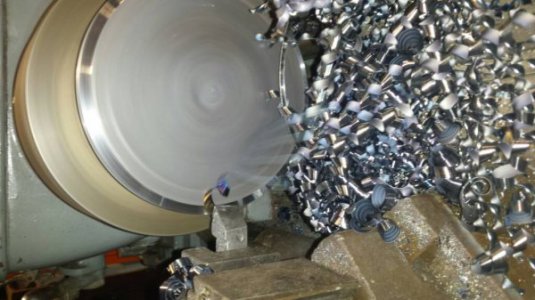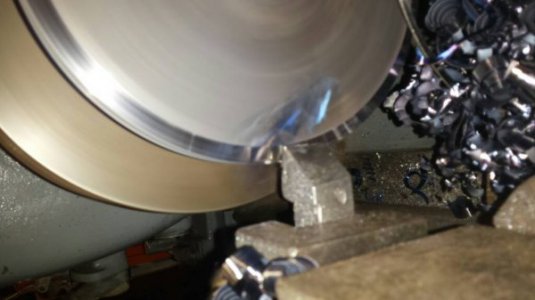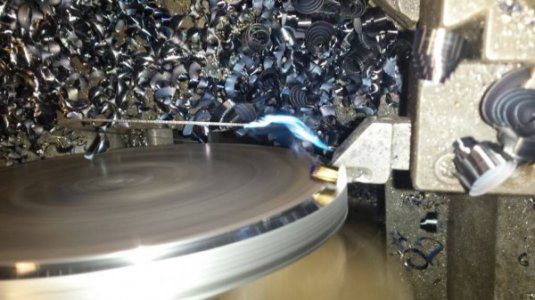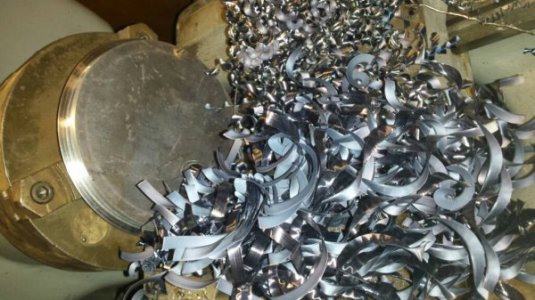-
Welcome back Guest! Did you know you can mentor other members here at H-M? If not, please check out our Relaunch of Hobby Machinist Mentoring Program!
You are using an out of date browser. It may not display this or other websites correctly.
You should upgrade or use an alternative browser.
You should upgrade or use an alternative browser.
Atmos Bellows Work?
- Thread starter tq60
- Start date
The bowl bottom is done for now.
Have many other projects to work on so it may be awhile.
Need to make the cover then drill and tap holes for retention screws and rubber feet.
First did a sandpaper polish of the outside but that was boring so we knurled it with a tiny size and it came out real nice.
The knurled surface feels sharp and almost works as a mail file. ;-)
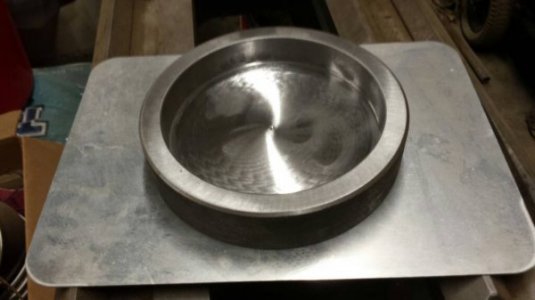
Sent from my SAMSUNG-SGH-I337Z using Tapatalk
Have many other projects to work on so it may be awhile.
Need to make the cover then drill and tap holes for retention screws and rubber feet.
First did a sandpaper polish of the outside but that was boring so we knurled it with a tiny size and it came out real nice.
The knurled surface feels sharp and almost works as a mail file. ;-)

Sent from my SAMSUNG-SGH-I337Z using Tapatalk
A little more work done over the weekend.
Made the top part.
While thinkinering this we realized we could not see the bottom when pressure testing and had an extra aluminum disc's so we are making another disk for a bottom to use for pressure testing.
Was in town yesterday so grabbed a couple more disc's for mistakes...
Tested the bellows in the freezer and nothing so it is empty of any usable gas and inspection of solder looks flaky.
Attached just a couple of the shots.
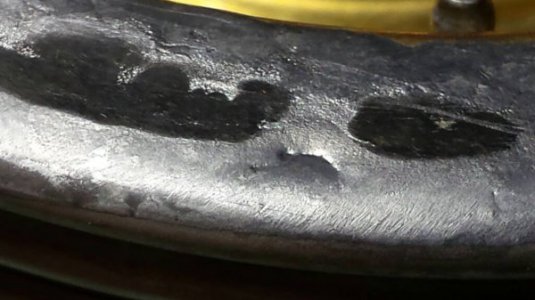
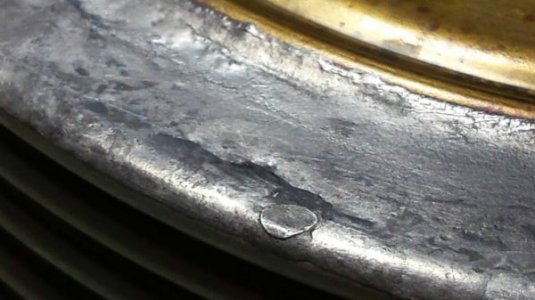
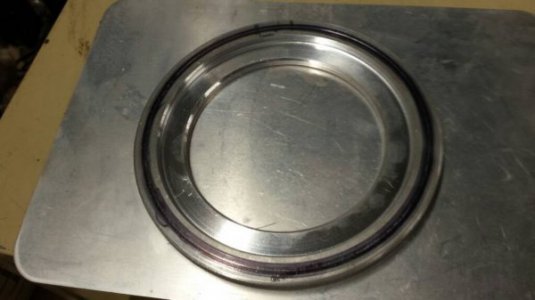
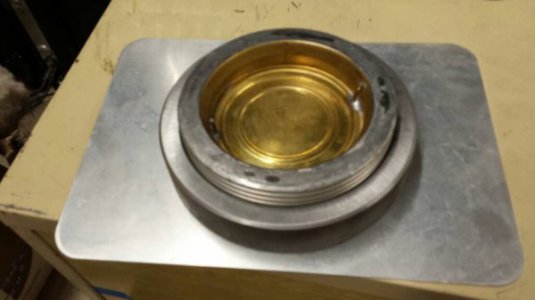
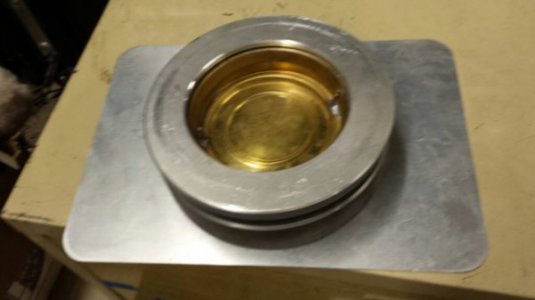
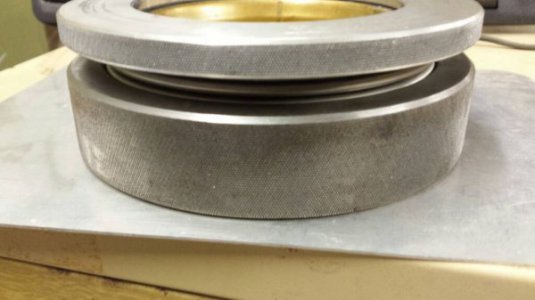
Sent from my SAMSUNG-SGH-I337Z using Tapatalk
Made the top part.
While thinkinering this we realized we could not see the bottom when pressure testing and had an extra aluminum disc's so we are making another disk for a bottom to use for pressure testing.
Was in town yesterday so grabbed a couple more disc's for mistakes...
Tested the bellows in the freezer and nothing so it is empty of any usable gas and inspection of solder looks flaky.
Attached just a couple of the shots.






Sent from my SAMSUNG-SGH-I337Z using Tapatalk
Spent more time today after chores send completed the lathe work.
Decided that the fixture would not be good for pressure testing as we could not see anything so we made a pair of covers from the aluminum that will become pressure clamps and a third that will become the lid to allow all of the different spacers and screws to be stored inside.
We are sketching out the hole patterns for holes to be drilled for viewing.
The pressure test covers will store on the bottom via thumb screws as will the top clamp ring and cover.
The pressure test covers will add mass to hold the cold longer to allow more time to fill and solder.
It weighs in at 7 pounds so it should be good.
We have a remote thermometer that we will place in the unit to test it out later.
Here are some photos so far.
When it is assembled for storage it looks like a steel hamburger with aluminum buns.
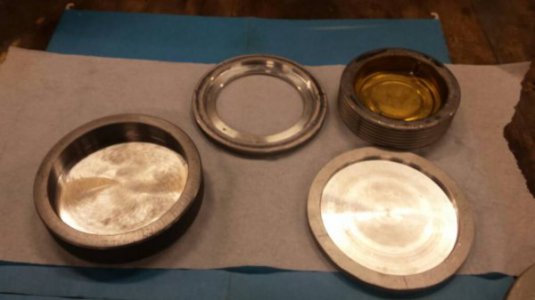
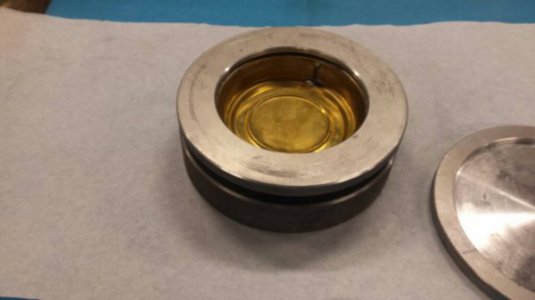
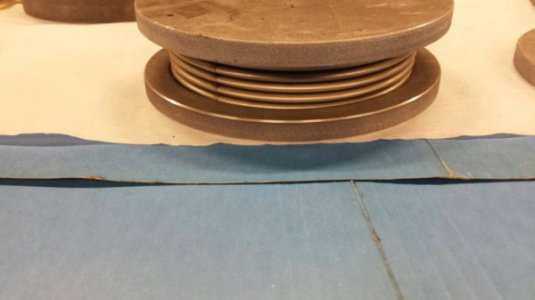
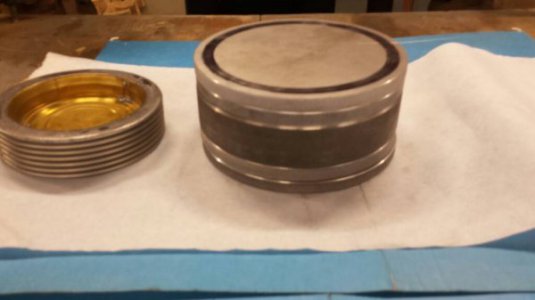
Sent from my SAMSUNG-SGH-I337Z using Tapatalk
Decided that the fixture would not be good for pressure testing as we could not see anything so we made a pair of covers from the aluminum that will become pressure clamps and a third that will become the lid to allow all of the different spacers and screws to be stored inside.
We are sketching out the hole patterns for holes to be drilled for viewing.
The pressure test covers will store on the bottom via thumb screws as will the top clamp ring and cover.
The pressure test covers will add mass to hold the cold longer to allow more time to fill and solder.
It weighs in at 7 pounds so it should be good.
We have a remote thermometer that we will place in the unit to test it out later.
Here are some photos so far.
When it is assembled for storage it looks like a steel hamburger with aluminum buns.




Sent from my SAMSUNG-SGH-I337Z using Tapatalk
Have been busy doing chores so no progress on the parts but we did score a cool accessory for it.
We were planning on using the shop air with a regulator but no air where planned work.
At a yard sale the DW did not want to stop at we found a small air pump for charging bicycle air spring forks.
It goes up to maybe 300 psi with little effort.
So easy pressurize.
Sorry about the mat but it is what was handy.
Also did some layout drawings to use to transfer the hole marks to a template so we get the holes drilled correct the first time.
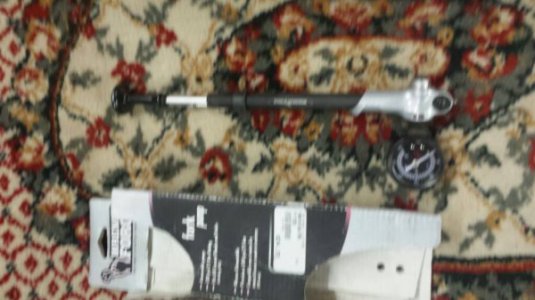
Sent from my SAMSUNG-SGH-I337Z using Tapatalk
We were planning on using the shop air with a regulator but no air where planned work.
At a yard sale the DW did not want to stop at we found a small air pump for charging bicycle air spring forks.
It goes up to maybe 300 psi with little effort.
So easy pressurize.
Sorry about the mat but it is what was handy.
Also did some layout drawings to use to transfer the hole marks to a template so we get the holes drilled correct the first time.

Sent from my SAMSUNG-SGH-I337Z using Tapatalk
Was able to tinker with this project a bit.
Made an alignment fixture to mark the holes and still had a bit of drifting with some of the more critical ones but made other adjustments.
Finished the "observation holes" in the covers for the pressure testing clamp and drilled the holes through the steel cooling cup and tapped them all the way through.
We wanted to do things differently but did not have a rotary table so a ring of holes will do for now...
Tapped holes for the screws to hold the feet on and the holes for the screws that hold it together.
That was the most risky task as it is 1.25 thick steel and did not want the metric tap to snap.
It was larger than our Kurt vise so we used a 2 X 4 in the vise and clamped to it so it held well.
Wanted to use thumb screws but they are expensive and not easy to find but noticed Allen screws look close enough and had some metric ones that were a good size and I'll buy some correct length later.
What is left is holes in cooling lamp cover and the storage cover then making a piston for supporting the center of the bellows when pressure testing and indicating holding pressure.
Last is the spacers for between the clamp faces.
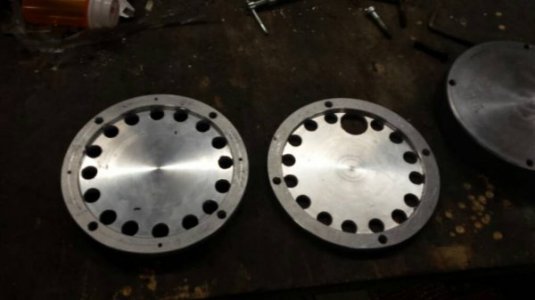
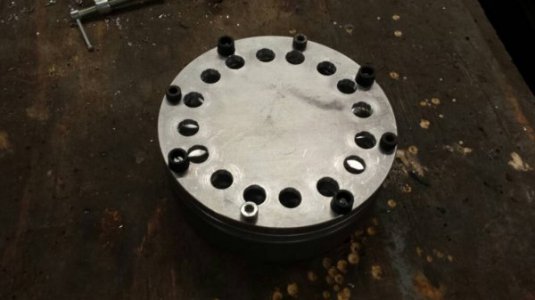
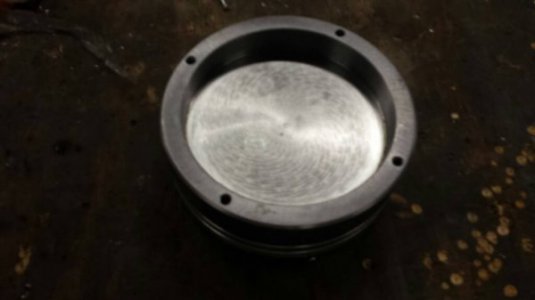
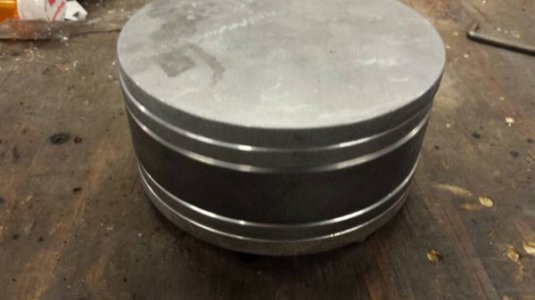
Sent from my SAMSUNG-SGH-I337Z using Tapatalk
Made an alignment fixture to mark the holes and still had a bit of drifting with some of the more critical ones but made other adjustments.
Finished the "observation holes" in the covers for the pressure testing clamp and drilled the holes through the steel cooling cup and tapped them all the way through.
We wanted to do things differently but did not have a rotary table so a ring of holes will do for now...
Tapped holes for the screws to hold the feet on and the holes for the screws that hold it together.
That was the most risky task as it is 1.25 thick steel and did not want the metric tap to snap.
It was larger than our Kurt vise so we used a 2 X 4 in the vise and clamped to it so it held well.
Wanted to use thumb screws but they are expensive and not easy to find but noticed Allen screws look close enough and had some metric ones that were a good size and I'll buy some correct length later.
What is left is holes in cooling lamp cover and the storage cover then making a piston for supporting the center of the bellows when pressure testing and indicating holding pressure.
Last is the spacers for between the clamp faces.




Sent from my SAMSUNG-SGH-I337Z using Tapatalk
Made the spacers today so the fixture is finished.
Added a support disk made from the slug removed from the cooling clamp cover.
It supports the boss where the bellows spring normally goes so when we apply some pressure the bellows holds it proper shape and is supported close to same way the clock does.
Could not find a suitable hose to connect the pump to the bellows.
We did find a chunk of tubing that is a bit small so we used it for the attached photos.
Tomorrow will be shopping day...hobby store for small brass tubing to make the coupler for the pump to tubing and some fuel line for the hose and maybe some type of spring clamp to secure it.
Then on to hardware store to get correct length metric screws to hold it all together, the ones we are using were in a bucket of estate sale hardware so different lengths and crudy...
With any luck next weekend we may be able to test it.
Still working on source for ethyl chloride.
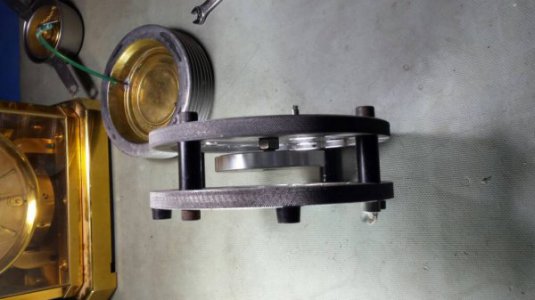
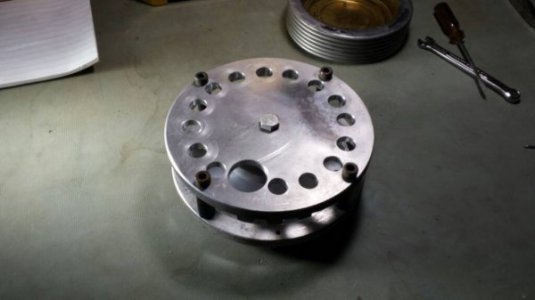
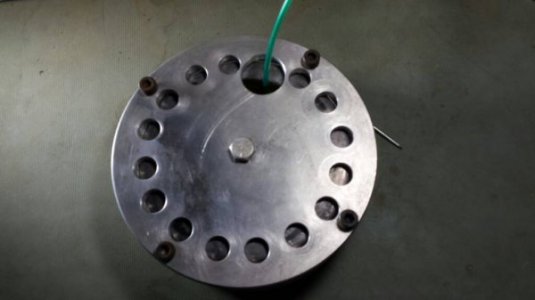
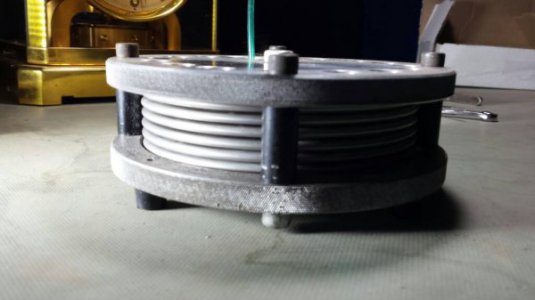
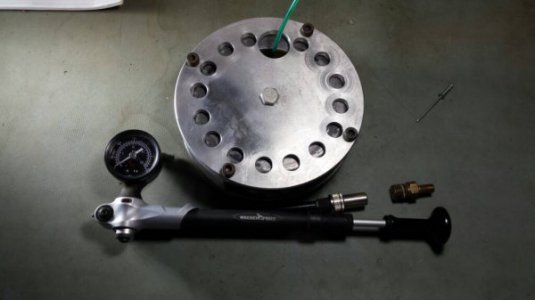
Sent from my SAMSUNG-SGH-I337Z using Tapatalk
Added a support disk made from the slug removed from the cooling clamp cover.
It supports the boss where the bellows spring normally goes so when we apply some pressure the bellows holds it proper shape and is supported close to same way the clock does.
Could not find a suitable hose to connect the pump to the bellows.
We did find a chunk of tubing that is a bit small so we used it for the attached photos.
Tomorrow will be shopping day...hobby store for small brass tubing to make the coupler for the pump to tubing and some fuel line for the hose and maybe some type of spring clamp to secure it.
Then on to hardware store to get correct length metric screws to hold it all together, the ones we are using were in a bucket of estate sale hardware so different lengths and crudy...
With any luck next weekend we may be able to test it.
Still working on source for ethyl chloride.





Sent from my SAMSUNG-SGH-I337Z using Tapatalk
- Joined
- Jan 22, 2011
- Messages
- 8,031
OK, I need a little enlightenment here. Exactly what is the objective, beyond simply getting the EC in a sealed bellows? Details please, if you don't mind. Clock repair may be in my future, so I may as well begin my knowledge base.
The atmos is self winding via a "thermal motor" which is a bellows filled with a small amount of ethyl chloride.
The group that we have are all made in the 50 ' s and they have lost their charge.
There is one party who charges them and not sure about repairing, but we saw the video and figured we could too but the clamps in the video were sloppy.
Being a tinkerer we came up with an idea then while digging at the scrap yard we located materials then the design popped.
We found a 1.25 inch thick steel disk slug that we made the "cooling cup", this along with a clamping cover are placed in the freezer with the bellows in place.
This weighs about 7 pounds and should keep it below boiling ( about 50 degrees) long enough to charge and solder the thing closed.
As we built it the design changed a bit as we determined we needed to figure out how they lost their charge and close inspection shows not so stellar soldering so we believe we could pressurize them like checking a tire for holes but needed to keep it from exploding so we made the disks with holes to allow us to hold it under water and pressurize it and look for leaks.
Struck out on the shopping trip today...The hobby store near work is long gone and hardware store thinks their screws are gold...driving into fresno later to mid valley to get the screws.
Sent from my SAMSUNG-SGH-I337Z using Tapatalk
The group that we have are all made in the 50 ' s and they have lost their charge.
There is one party who charges them and not sure about repairing, but we saw the video and figured we could too but the clamps in the video were sloppy.
Being a tinkerer we came up with an idea then while digging at the scrap yard we located materials then the design popped.
We found a 1.25 inch thick steel disk slug that we made the "cooling cup", this along with a clamping cover are placed in the freezer with the bellows in place.
This weighs about 7 pounds and should keep it below boiling ( about 50 degrees) long enough to charge and solder the thing closed.
As we built it the design changed a bit as we determined we needed to figure out how they lost their charge and close inspection shows not so stellar soldering so we believe we could pressurize them like checking a tire for holes but needed to keep it from exploding so we made the disks with holes to allow us to hold it under water and pressurize it and look for leaks.
Struck out on the shopping trip today...The hobby store near work is long gone and hardware store thinks their screws are gold...driving into fresno later to mid valley to get the screws.
Sent from my SAMSUNG-SGH-I337Z using Tapatalk
We had success yesterday at the hobby store and things have changed in the 10 years since we been to one...everything pre packaged and narrow selections with no more bulk things...but back to topic.
Got some small fuel line to couple the air pump to the bellows and a chunk of brass tubing for the adaptor.
Stopped by a hardware store and got some 1/8 inch o rings for slip clamps.
Today after chores we got to try it out.
SUCCESS !!!!
The ports were crimped and soldered so we used a dental bur in a high speed hand piece to cut it off.
We will make a tapered wire plug that we can solder in place to plug it.
Inserted the bellows into the fixture and pumped it up to about 10 psi and dunked it in water and sure enough BUBBLES!
Shifted and refilled to get bubbles in center of a viewport and scratched it.
It looks okay but tiny tiny spot so re flowed the area with some added solder and flux ten retested at 50 psi and no bubbles so test and repair was a success.
We still need to get some EC but now we have confirmed why the bellows failed and have repaired it and confirmed sound repair.
Note to others...
With just lung pressure you can make the bellows expand so considering the large size the area of the effective piston is fairly large so a minimal pressure can push quite a bit.
The clamp holds well but for fun we just pumped a few strokes with the pump and the hand tight screws were drawn tight and could no longer be turned by hand even though the needle on the indicator bib not move.
So if you wish to pressure test one be sure to make a cage that properly supports the unit to avoid damaging it.
The loose hardware all stores inside the unit.
Some photos...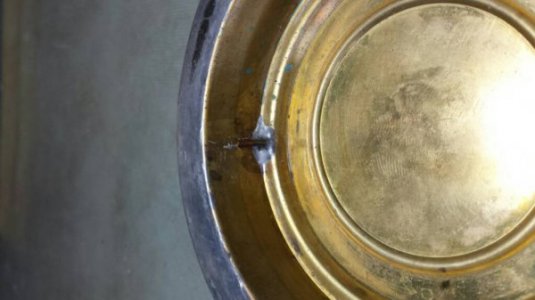
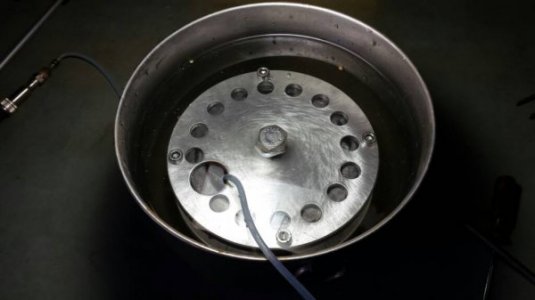
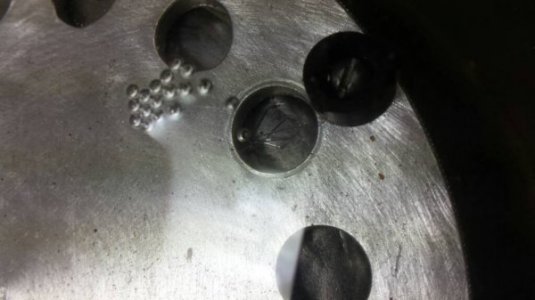
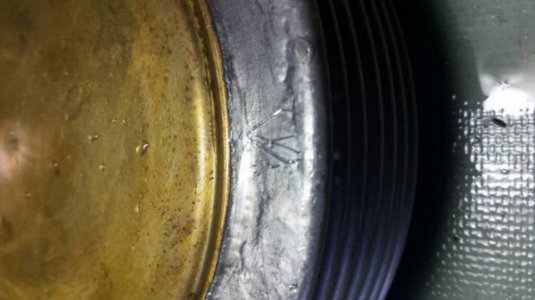
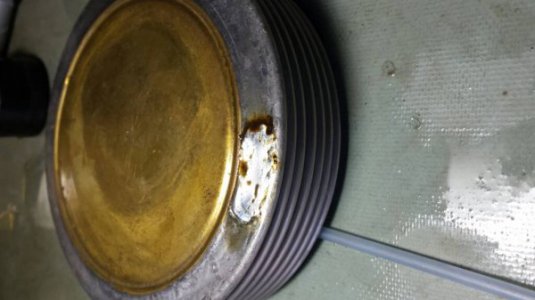
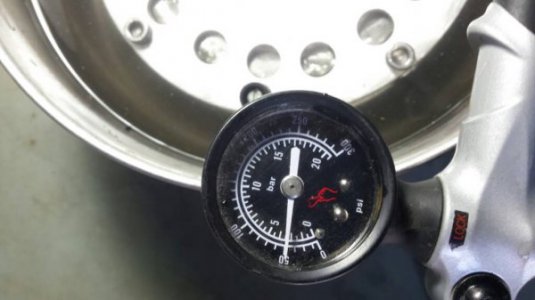
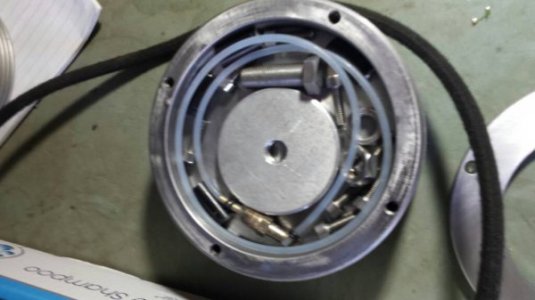
Sent from my SAMSUNG-SGH-I337Z using Tapatalk
Got some small fuel line to couple the air pump to the bellows and a chunk of brass tubing for the adaptor.
Stopped by a hardware store and got some 1/8 inch o rings for slip clamps.
Today after chores we got to try it out.
SUCCESS !!!!
The ports were crimped and soldered so we used a dental bur in a high speed hand piece to cut it off.
We will make a tapered wire plug that we can solder in place to plug it.
Inserted the bellows into the fixture and pumped it up to about 10 psi and dunked it in water and sure enough BUBBLES!
Shifted and refilled to get bubbles in center of a viewport and scratched it.
It looks okay but tiny tiny spot so re flowed the area with some added solder and flux ten retested at 50 psi and no bubbles so test and repair was a success.
We still need to get some EC but now we have confirmed why the bellows failed and have repaired it and confirmed sound repair.
Note to others...
With just lung pressure you can make the bellows expand so considering the large size the area of the effective piston is fairly large so a minimal pressure can push quite a bit.
The clamp holds well but for fun we just pumped a few strokes with the pump and the hand tight screws were drawn tight and could no longer be turned by hand even though the needle on the indicator bib not move.
So if you wish to pressure test one be sure to make a cage that properly supports the unit to avoid damaging it.
The loose hardware all stores inside the unit.
Some photos...







Sent from my SAMSUNG-SGH-I337Z using Tapatalk


